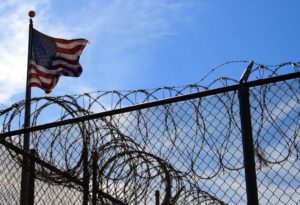The Terrorizing of People in Their Own Homes Is Alive and Well
A recent database shows that harassment of black families where they live is still an issue decades after the civil rights movement. Juan José Aza / CC BY-NC-ND 2.0
Juan José Aza / CC BY-NC-ND 2.0
In Delano, Minnesota, a black family’s home was broken into in March 2017 and a warning was spray-painted on the walls: “Get out.” The vandals left a note, too: “Next time it’s going to be fire.”
In Athens, Tennessee, the white mother of young biracial children alleged that she’d been harassed verbally by a neighbor for a year.
For close to two years, ProPublica has been compiling reports of hate crimes and bias incidents as part of our Documenting Hate project. The database now houses a vast compendium of ugliness in America. Killings, assaults, threats of terror — they are all there.
One of the more common entries involves people being harassed or threatened at their place of residence, often by neighbors, the people who live next door or down the hall or around the corner. Of course, this isn’t new. The integration of neighborhoods in the U.S. has been as fraught as the integration of the country’s schools.
Jeannine Bell, a lawyer and author of “Hate Thy Neighbor: Move-In Violence and the Persistence of Racial Segregation in American Housing,” said no corner of the country has any claim of immunity from the problem. She also noted that the total number of such incidents is not reliably captured in any formal data set, ours or those kept by federal and local authorities. That’s because, she said, many of these incidents go unreported.
“A lot of times, the people that are targeted don’t even know that this is a crime,” Bell said.
The Documenting Hate database has close to 6,000 entries — a mix of news reports, tips, personal stories of bigotry and records collected by law enforcement and some anti-discrimination groups. Among the most common things reported are anti-Muslim acts, which accounted for 359 entries, and swastikas showing up in public places, which were the subject of an additional 400 or so.
More than 300 entries were reports of harassment or menacing at people’s homes, targeting people of a variety of races and religions. The most frequent victims were African Americans. Indeed, African Americans are the most frequently victimized group nationally for hate crimes, according to data from the FBI.
That finding prompted us to send inquiries to the dozen or so police jurisdictions that had reported the highest number of anti-black hate crimes to the FBI’s hate-crime database from 2010 to 2016. Since we couldn’t get incident reports from every one of those jurisdictions, we also made requests to several police departments where we’d received data that included anti-black hate crimes.
In total, we were able to identify 639 incidents of anti-black violence or harassment from the police reports we received. More than a fifth of those reports, 138 in all, were incidents involving people being targeted by neighbors or in their homes.
In Columbus, Ohio, a man went to police because someone had been ringing his doorbell or banging on his garage 25 to 30 times a night, almost every night. When the man went outside, the suspect would call him racial slurs from the darkness. The man and his family are the only black residents of their cul-de-sac. No arrests were made and the case is currently listed as inactive.
In Toledo, at the north end of the state, a man was allegedly harassing three black neighbors in his neighborhood, using “unwarranted racist language,” according to the police report. One day, the suspect saw a car with black occupants throw trash on the street. Even though they had no relation to anyone on the block, the suspect came over and dumped trash on a black family’s lawn, the report said. “Since you all want to nigger up the neighborhood, I’ll burn you and your nigger family out,” he allegedly told the victim. Police went to the suspect’s home, but he didn’t answer the door. A call to the Toledo police to check on the case was not returned.
In Kansas City, Missouri, an African-American man went to police because his neighbor had harassed him for three years. The suspect allegedly stood in his driveway taking pictures of his home and waved a Confederate flag. The man who filed the complaint wound up moving, but he told police he was worried because he’d seen the man outside his new home.
In Oxford Township, Michigan, a couple — a white woman and a black man — went to police because they said they couldn’t leave the house without getting harassed by their neighbor, who called them racial slurs. When police gave the neighbor a citation for disorderly conduct, she ripped it up in front of the officer. She was subsequently arrested for disorderly conduct and her case was turned over to the local prosecutor’s office.
And in Spokane, Washington, we got records on two cases of possible neo-Nazis harassing their black neighbors. In one case, the neighbors reported that a man with a swastika on his hand called them racial slurs. He allegedly threw a brick at a woman, calling her a slur. In another case, a black man said his white supremacist neighbor and another man assaulted him in his garage while using racial slurs and threatened him with a gun. “Nigger, you don’t deserve to be breathing white men’s air,” they allegedly said. Later, the white supremacist allegedly returned with two other men and yelled “heil the KKK” and “white power” at the man, shortly before shooting a gun at his home from a car. The victim told The Spokesman-Review that one of the suspects had called him racial slurs for months leading up to the shooting.
According to the Spokane Police Department, both cases resulted in arrests and the suspects were charged with first-degree assault and malicious harassment. In the shooting case, suspect Donald Prichard’s criminal history record totals to 16 felony convictions, which included beating and sexually assaulting a woman. He’s awaiting trial on Jan. 22. The second suspect in that case, Jason Cooper, has 12 felony convictions, including unlawful possession of a weapon and burglary, and he is awaiting trial on Feb. 25.
Many accounts, both in our database and that resulted from our queries to police departments, include frustration at what can seem like a lack of police interest or action. In the case of the family targeted in Delano, no one was ever arrested, and the family wound up moving away. The mother in Athens said police told her there was little they could do about verbal harassment, that it was a civil matter. The authorities in Athens didn’t return a request for comment.
That said, we did find examples where the authorities ultimately took serious steps.
In Grapevine, Texas, Dante Petty was harassed by his white neighbor, Glenn Halfin, for over a year after he moved in. The harassment became so persistent that he installed surveillance cameras outside his home and a police officer was stationed outside for over a month. The breaking point occurred when his neighbor left black baby dolls with nooses around their necks hung outside his apartment. Ultimately, Halfin was charged with a hate crime and convicted of violating the family’s housing rights. He was sentenced to year in state prison, the maximum punishment based on his guilty plea to the misdemeanor charge.
“No one should be afraid to go home at night,” said U.S. Attorney Erin Nealy Cox on the day of Halfin’s sentencing. Victims of such harassment at their residences, it turns out, have an option other than going to the local police. Harassing one’s neighbor also violates the federal Fair Housing Act, which makes it illegal for landlords and neighbors to interfere with someone’s right to housing based on who they are. And there is an office at the Department of Housing and Urban Development meant to handle such cases.
Victims can file a complaint with HUD within a year of the alleged violation. Owners, managers and condominium associations may be liable for neighbor-on-neighbor harassment if they fail to intervene when they have a duty to do so. Criminal penalties can include fines and prison.
According to HUD statistics, there were 8,348 complaints of such violations in 2015, 8,350 in 2016 and 8,186 in 2017. Half or more of those cases dealt with alleged violations involving people with disabilities. The HUD statistics show that, historically, very few of the complaints of any kind wound up with federal prosecutions.
The number of prosecutions has gotten appreciably smaller in recent years. In 2015, the Department of Justice closed 84 cases brought to it by HUD regarding the Fair Housing Act. In 2016, there were only 12. In 2017, there were just five.
Calls for comment from HUD were not returned because of the federal government shutdown.
Meanwhile, as the second year of Documenting Hate came to a close, reports kept coming in.
In June 2018, Hubert Roberts, of Clio, Michigan, complained to police that his truck had been targeted by racists. A Nazi symbol was spray painted on the truck, along with slurs and boasts of white pride. The Genesee County Sheriff’s Office would not comment on the case, other than to say no arrests have been made. When asked about the current status of the case, the FBI told ProPublica, “Adhering to DOJ policy, the FBI neither confirms nor denies investigations.”
Roberts said that this wasn’t the first time he was targeted in the community because of his race, either. He noted other instances of being called racist comments, where he was told to “go back to Africa,” while doing work on his yard.
“This could have been an opportunity for some dialogue in this predominantly white community,” Roberts said. “I just feel really disappointed with our justice system.”
Your support matters…Independent journalism is under threat and overshadowed by heavily funded mainstream media.
You can help level the playing field. Become a member.
Your tax-deductible contribution keeps us digging beneath the headlines to give you thought-provoking, investigative reporting and analysis that unearths what's really happening- without compromise.
Give today to support our courageous, independent journalists.






You need to be a supporter to comment.
There are currently no responses to this article.
Be the first to respond.